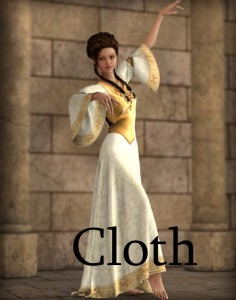 Poser’s Cloth Room is not only used to drape tablecloth over statues and cars, but is also, or even mainly, used to make clothes worn in the most natural way. This brings the high-brow world of fibre simulation physics to the table of the 3D artist, not the smoothest combination of environments. Time for some support.
Poser’s Cloth Room is not only used to drape tablecloth over statues and cars, but is also, or even mainly, used to make clothes worn in the most natural way. This brings the high-brow world of fibre simulation physics to the table of the 3D artist, not the smoothest combination of environments. Time for some support.
At the moment I can offer you:
Series
Each reference below links to the first post in the series. From there you can easily select any individual post (footer, right).
- Case Study: Covering Up
These articles present the fundamentals of draping cloth over statues and cars. This addresses nice folding cloth in stills as well as stretching and waving of cloth in animations. These articles serve as a Cloth Room for Beginners tutorial. - Case Study: Dressing Up
These articles present the fundamentals of draping clothes over a (moving) human figure. This addresses the most used (and most tedious) aspects of Poser Cloth Room is life. These articles too serve as a Cloth Room for Beginners tutorial. - Poser Dynamics I
Introduction to the following vast amount of articles on Poser Dynamics: Hair and Cloth Room. Overview of the Case Studies, and checklists for the hair and cloth developer as well as user. - Poser Dynamics II
Quick Tours through Cloth Room and Hair Room, and Quick Recepies to solve the most common issues. - Poser Dynamics III
Okay, faster your seatbelts, this is the “How to get your PhD in Poser Cloth Simulation” section covering all details of the way cloth simulation is done the Poser way. - Poser Dynamics IV
Just to relax after the previous run, these articles present some background and historical info on Poser in general, on Cloth Room in particular, and on Cloth Simulation in general as well. Food for those who insist on rebuilding the thing. And for those who like a peek into the future. - Poser Dynamics V
Okay, just for those who want it the math and physics way – and did not get a headache from part III. Those articles will stop you asking why. You can live without, but it’s there.